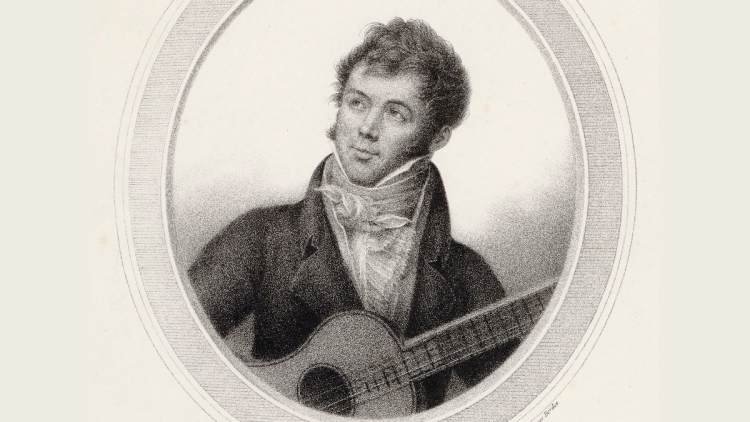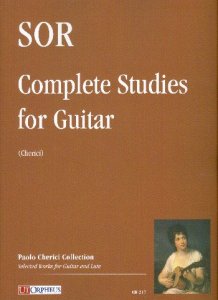Biography
Spanish guitarist and composer Fernando Sor (1778-1839) wrote some of the most popular etudes for beginner and intermediate guitarists. He is also known for composing more complex pieces, including an opera, ballets, and symphonies.
The Sor pieces classical guitarists perform most often are: Grand Solo, Op. 14 and Variations on a Theme by Mozart, Op. 9.
Fernando Sor lived in various countries in Europe, including Spain, Paris, London, and Moscow. He was drawn to music from an early age. As he grew up and performed more, Sor’s virtuosic guitar skills gained him worldwide renown. His most prolific composing period happened in retirement, during the last decade of his life.

Despite his studies having sweet melodies and light harmonies, Sor comes across as somewhat disgruntled in his old age. This is evident from his Op.43 entitled Mes Ennuis (“My Annoyances”), and his sarcastic foreword to Op.45:
“Let’s see if that’s that. Six short and easy pieces in stages, which aim to lead to what has generally been agreed are difficulties. Composed and dedicated to the person with the least patience, by Fernando Sor. Opus 45.”
Sor died from tongue and throat cancer at the relatively young age of 61.
For a more in-depth biography of Sor, I recommend you get the 2020 PDF edition by Brian Jeffrey below:
Pedagogy
Fernando Sor’s studies are some of the most commonly played and effective studies for beginner and intermediate classical guitarists.
Below are two of the best sources for Fernando Sor studies, lessons and exercises:
The editions above are fantastic print editions. However, you might also want to check out these newly revised PDF editions by Brian Jeffrey, some of which are free.
You can also find even more free classical guitar sheet music by composer Fernando Sor on IMSLP.
Méthode pour la guitare
Sor’s comprehensive Méthode pour la guitare is an important manual covering scales, harmony, theory, and composition.
You can download Sor’s Méthode pour la guitare for free here.
Sor Studies
In addition to Fernando Sor’s Méthode pour la guitare, he also composed many collections of popular studies for guitar.
Here’s a list of those collections in order from easiest to most difficult:
- Op. 60 (Introduction à l’étude de la guitare)
- Op. 44 (24 Petites pièces progressives)
- Op. 35 (24 Exercices très faciles)
- Op. 31 (24 Leçons progressives)
- Op. 6 (12 Etudes)
- Op. 29 (12 Etudes)
I’ve featured some of these studies on my album 20 Classical Guitar Etudes for Beginner & Intermediate Students, and on my YouTube channel. You can hear and see some of these studies below:
Op.31, No.1: Andante
Fernando Sor’s Op.31, Etude No.1 is a fine composition in the key of C major. This is a popular Sor study that’s great for beginner classical guitar students. This piece is especially effective for those wishing to practice reading harmony. You can also learn how to bring out a clear and definitive melody.
Sor’s Op.31 Etude No.1 is in 3/4 time, and often features a dance-like pulse emphasizing beats one and three. The tempo for the piece is a moderate Andante (typically played between 76–108 bpm). Although relatively simple, this piece can be very beautiful when played with emotion and intent!
Spotify: Etude No. 1, Op. 31: Andante
Sheet Music: Etude No.1, Op.31: Andante
Op.31, No.3: Allegretto Moderato
Fernando Sor’s Op.31, Etude No. 3: Allegretto moderato is an upbeat, lively study for students advancing to the intermediate level. The piece is in the key of D major, 6/8 time, giving the piece a dance-like quality.
Etude No.3 offers a variety of techniques that can be tricky to to play at the appropriate tempo (85-110 BPM).
Spotify: No. 3, Op. 31: Allegretto Moderato
Sheet Music: No.3, Op.31: Allegretto Moderato
Op.35, No.1: Andante
Fernando Sor’s short beginner guitar etude entitled Andante is an excellent introduction to harmony, and playing two parts at once. Sor’s Opus 35, Etude No.1 is meant to be played at a moderately slow pace.
Spotify: No. 1, Op. 35: Andante
Sheet Music: No.1, Op.35: Andante
Op.35, No.2: Andantino
Fernando Sor’s Op.35 Etude No.2: Andantino is a lively, dance-like etude in C major, 3/8 time. This beginner classical guitar etude is terrific for students who are learning to read common patterns in first position.
The harmonies in this etude keep the piece moving in a crisp and deliberate manner.
Spotify: No. 2, Op. 35: Andantino
Sheet music: No.2, Op.35: Andantino
Op.35, No.3: Larghetto
Sor’s tragic Op.35 Etude No.3: Larghetto feels like a funeral march. This piece gives students the opportunity to practice finding the balance between chord voices. It’s also full of rich harmonic phrases. Therefore, this piece is still suitable for students at the upper beginner level.
Spotify: No. 3, Op. 35: Larghetto
Op.35, No.22: Allegretto (Study in B minor)
Etude No.22, Op.35 is possibly Sor’s most well-known classical guitar study. This study was included in Segovia’s Twenty Studies for the Guitar. As a result, it’s one of Sor’s most popular studies.
Study in B minor is appropriate for guitarists at the early intermediate stage. This study sounds simple and somewhat repetitive. However, there are lots of nuances and tricky shifts that you only realize when learning to play it for yourself!
Spotify: No. 22, Op. 35: Allegretto (Study in B Minor)
Popular Works for Guitar Solo
Introduction and Variations on a Theme by Mozart, Op.9
Introduction and Variations on a Theme by Mozart, Op.9 is arguably Fernando Sor’s most well-known solo composition. Sor dedicated Op.9 to his brother Carlos. The piece was first published in London, 1821.
The work is based one of Mozart’s themes called “Das klinget so herrlich”. This theme is played near the end of Act I of The Magic Flute opera.
Sor’s Op.9 demands virtuosic right and left hand techniques, while exploring the entire fretboard in range of colorful interpretations. The bold chords, quick scale runs, elaborate slur passages, and rolling arpeggio patterns display so much of what the guitar has to offer. As a result, this is one of the most well-rounded compositions in classical guitar repertoire.
Grand Solo, Op.14
Grand Solo, Op.14 is one of Fernando Sor’s most impressive and technically challenging compositions. Sor’s Grand Solo is majestic, bold, and expressive!
This epic piece includes frequent use of the pedal bass technique. In other words, you can hear a consistent, repeating bass note over melodic material.
The Grand Solo is mostly in major keys, with bright cadences up and down the fretboard. The piece builds up to an exciting and brilliant conclusion.



